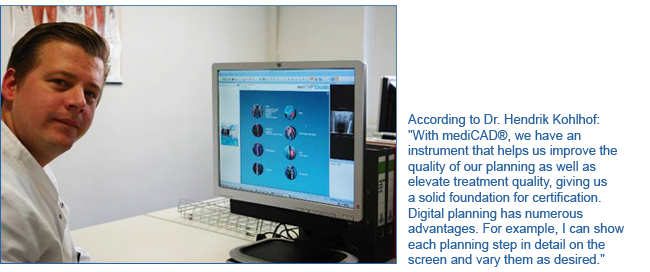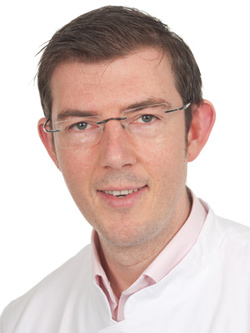



Published, 30.08.2022

The Bonn University Hospital in Germany includes the Clinic and Polyclinic for Orthopedics and Trauma Surgery. Revision prosthetics is one of this institute’s areas of specialization. Each year, they implant approximately 600 knee and hip prostheses, approximately 50% of which are replacement endoprostheses.
The hospital has been using the mediCAD® orthopedic planning solution from hectec since 2012 when they replaced their older conventional planning system. The hectec application is a CAD solution with which implants and associated components can be superimposed on radiology images. For example, a suitable cup and shaft combination can be efficiently planned on the system in preparation for a hip operation. The system works very reliably for replacement interventions as well.
The current version contains a significant number of new functions and has been given a refreshing face lift. Automation and revised operating procedures accelerate completion of common processes. In total, the new version contains more than 100 new functions and changes. hectec GmbH has been continuously developing its “mediCAD® Classic” planning solution since 1999. It is a certified solution and has global approval as a medical product. mediCAD Classic® incorporates all planning methods and documents processes for legal security. hectec’s proprietary database of implantation products is an important aspect of the solution because it enables doctors to immediately select the most ideal implant directly on the screen. The database is continuously expanded. It currently includes products from 90 global manufacturers and covers more than 80% of all implants used in Europe.
This digital planning and documentation program has replaced obsolete analog planning methods that rely on radiograph films and planning templates. The modern system eliminates the need to print out films as well as potential sources of errors associated with this process. This saves not only time, but money as well. The certainty provided by the system was very important.
These reasons, together with initiation of the EndoCert project for quality assurance in endoprosthetics, were the primary drivers behind their decision. According to Department Head Dr. Pierre Göbel and Assistant Doctor Hendrik Kohlhof: „We were looking for a way to improve the quality of our pre-operational planning and simultaneously use this planning as the foundation for our certification. This is very interesting for us because we are one of the first ten pilot hospitals for certification as an Endoprosthetics Center for Maximum Care in Germany.“

A digital solution fulfilled both expectations.
Positive feedback from colleagues and other hospitals was also a consideration.
The chosen solution from hectec GmbH of southern Germany was easy to install and launch. Users in Bonn have found the program to be intuitive to use.
A short but intensive training of users with interactive use of the planning solution was adequate, but hectec remained in contact during the introductory phase in order to resolve questions as they arose. Even more experienced colleagues were very accepting of the new technology. Automatic optimization of how individual prosthetic parts are combined proved to be a special benefit. “Automatic fitting of prosthetic parts shows me at a glance whether my selections will work or not,” according to Department Head and QMA Dr. Pierre Göbel. This step-by-step approach to planning also ensures that nothing is forgotten. Once the surgeon has selected the best-fitting implants by manufacturer, type (cup and shaft, for example), model, version, and size, he or she can use the arrow keys on the keyboard to interactively fit the size, position, and inclination of the cup on the screen. Each implant can be rotated, enlarged, or made smaller.
Die gewählte Lösung der hectec GmbH aus Landshut ließ sich unkompliziert installieren und einführen. Das Programm ist nach den Erfahrungen aus Bonn intuitiv zu bedienen. Eine kurze, aber intensive Schulung der Mitarbeiter mit interaktivem Erarbeiten der Planung war ausreichend, zudem standen die Mitarbeiter der Firma jederzeit bei weiteren Fragen in der Einführungsphase zur Verfügung. Auch erfahrenere Kollegen konnten sich mit der neuen Technik gut anfreunden.
Insbesondere die automatische optimale Kombination der einzelnen Prothesenteile erweist sich hier als Vorteil. “Ich sehe durch die automatische Einpassung aller Prothesenteile auf einen Blick, ob meine Auswahl stimmig ist” so Oberarzt und QMB Dr. Pierre Göbel. Diese schrittweise Planung garantiert auch, dass nichts vergessen wird. Hat der Operateur auf dem Bildschirm das optimal passende Implantat nach Hersteller, Art (z.B. Pfanne, Schaft), Typ, Ausführung und Größe ausgewählt, passt er die Pfannengröße, -Lage und -Inklination interaktiv mittels Pfeiltasten auf der Tastatur ein. Jedes Implantat lässt sich drehen, vergrößern oder verkleinern.

Once all corrections have been completed on the radiograph, mediCAD® merges the templates and optimizes how they fit together. This automatic calibration makes a separate scaling step unnecessary. The final planning is then saved and documented without losses, ensuring legal security. If the planning is preliminary, it will remain in mediCAD® and can be refined at any time.
The program facilitates optimal planning of knee prostheses in particular by utilizing the complete mechanical axes needed during pre-op planning. The benefits of the program are plain to see: Prosthesis planning is significantly more precise.
According to Department Head Dr. Pierre Göbel:
„Having a reliable means of pre-operative planning and documentation is always important, but even more so within the context of the EndoCert Initiative for quality assurance in endoprosthetics.“
Due to their specialization in revision prosthetics, the team in Bonn takes full advantage of the large collection of implants stored in the system. Using mediCAD®, the team can access approximately 80% of all implants offered throughout the world. They can even identify “exotic” implants and properly replace problematic parts or add new parts. Approximately eight cup systems and eight shaft systems are used on a regular basis. Most of the patients treated in Bonn are not standard cases, but instead exhibit symptoms that require special techniques and skills. Examples include infected prostheses or replacement of entire bones. In virtually every case, differentiated and individualized planning is required. Careful planning is especially important for complex replacement endoprostheses.
In cases of dysplasia and congenital growth abnormalities, digital tools enable rapid and accurate planning to the extent that the patient does not require an individualized solution (custom prosthetic), which would be planned using specialized reconstruction CTs. In situ examination is both easier and results in higher quality. Images may be enlarged as desired, rotations varied, and sizes changed. As a result, problems are more likely to be detected before the operation. “We are spending less time preparing for operations and encountering fewer difficulties,” according to the team. “It is extraordinary how well the implants used intra-operatively match with the pre-operative hectec planning.” Analog planning that would have taken 15 to 20 minutes now requires only 5 to 6 minutes and simultaneously produces higher quality and better documentation. In addition, the hospital saves money it would have spent for film and copies.
In the experience of the surgeons in Bonn, hectec mediCAD® enables better planning in less time, especially with more complex cases. Saving time simultaneously boosts quality significantly.